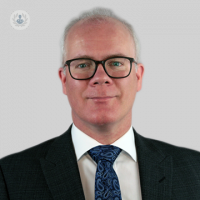Everything you need to know about pacemakers
Written by:Pacemakers are devices which work to regulate the heartbeat and statistics show that over half a million people in the UK have the pacemakers implanted. Leading consultant Allan Harkness explains everything you need to know about pacemakers, including how they work and their history, as well as the most recent developments in pacemaker technology.

What does a pacemaker do? Who is a good candidate for one?
A pacemaker is designed to stop the heart from going too slow. It listens to the heartbeat, and if the heartbeat is slower than it should be, the pacemaker will send a signal down the wire and into the heart, in order to stimulate the heart to go at a faster pace.
This signifies that the person who is most likely to benefit from a pacemaker is someone whose heart is going too slow, has a tendency to go too slow, or sometimes even pauses, which may cause them to feel dizzy, lethargic or provoke blackouts.
How does a pace pacemaker work?
A pacemaker works by having a small electronic device in the top corner of the chest, with one or two wires generally running down into the heart. The pacemaker circuits listen to the heart because the heart is an electrical organ. It is possible to listen to the heartbeat by detecting the electrics. The pacemaker will often be listening to the heartbeat, and in turn, report that your heart is ok.
However, sometimes the pacemaker will detect that the heart is going too slow, in which case, it sends a small electrical current into the heart, which stimulates either on the top or bottom chambers of the heart, to go to a more normal speed.
In cases when the patient’s heartbeat is not fast enough, the pacemaker will take over and run all of the time. However, most modern pacemakers try to not run all of the time, if the heart is going at a reasonable speed.
Can anything affect a pacemaker once it is in the body?
There are some things that can affect pacemakers. It is fairly uncommon nowadays to be in a situation where that may be a problem. Arc welding was a big problem in the past, but in modern life, arc welding isn’t common, and therefore, is no longer a major problem.
Magnets can cause a problem with pacemakers, meaning that as a consequence, we generally advise people not to have their mobile phone in their pocket right next to the pacemaker.
Additionally, in the past, we were very concerned with the link between MRI and pacemakers, however, that is no longer an issue in most centres. There are some concerns with induction hobs, however, unless you lean directly over the induction hob, this is not a major concern.
When the pacemaker is first put in place, its leads are not as well adjusted to the body and do not stick in place, therefore we would advise that on the first day of using your implant, you should restrict the use of that arm. For example, you should not swing that arm or reach up, so that the pacemaker and the leads can get settled in, which is usually the case for the first three months.
How long have pacemakers been used? Are they safe?
Pacemakers have been in use for about 60 years, and technology has progressed enormously over the years. In the past, a very large device had to be inserted into the tummy, whereas now there are very small devices that can go in the chest, or even some tiny devices that can fit inside the heart itself.
The pacemaker device itself is extremely safe and reliable, and it's incredibly rare for a pacemaker to become faulty. Very rarely, the leads themselves can become damaged or break, but this is highly unusual and does not commonly occur. Additionally, the complication rates from putting in pacemakers are low.
What are the most recent developments in pacemaker technology?
Pacemakers can now be put in people and an MRI can be safely performed. In fact, I put in the first pacemaker that was MRI-compatible in the Essex region many years ago, and the patient successfully had MRIs of both the head and heart.
In the last few years, an advance that has been spurred on by the coronavirus is the fact that we can now do remote monitoring. Patients now can have a little box that sits underneath their bed and talks to the pacemaker every night and asks the pacemaker whether it is working correctly. It then sends that information back to your pacemaker centre.
This means that patients are not required to travel up to the cardiac centre every three or six months to physically visit the department. They can feel reassured knowing that the pacemaker is being watched every single day to ensure that if there were any issue with the pacemaker, or any change in heart rhythm of concern, the cardiac centre would be able to see that and respond to that very quickly.
If you would like to book a consultation Dr Harkness, do not hesitate to do so by visiting his Top Doctors profile today.


